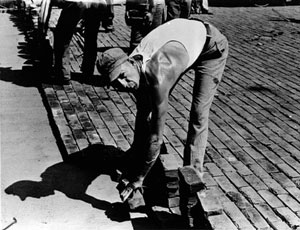The first place the Obama administration can triumph or mess up is the $825-billion proposed economic stimulus package�the new administration�s centerpiece plan. At question is whether a spending plan such as what the House of Representatives is now considering is a vital Keynesian solution to what ails the U.S. economy or a hindrance to a vibrant business rebound that won�t depend on massive government spending. The answer to that may be hidden in the fog of historical controversy about what really happened during the Great Depression.

Of special interest is the year 1937. Up until then, Franklin Delano Roosevelt�s New Deal had a couple of successes. Bank deposits were safely insured and economic activity had returned to the level of 1929, the year of the big stock market crash. Unemployment had fallen from its 1934 high of 23.2% to 15%. But then the economy started sinking again in what has been described as the Roosevelt Recession. What happened?
Until it was outlawed by the Supreme Court, the keystone of the first part of the New Deal was the National Recovery Administration, an experiment in industrial planning through which business observed codes of fair competition and set wages, mainly driving them higher and increasing production costs. It was a disaster with lingering bad effects, claims Lee Ohanian, professor of economics at the University of California, Los Angeles. Most of the damage was done by interfering in what should be private business.
�Those policies were the most destructive because they really prevented markets from operating,� says Ohanian. To Roosevelt�s most strident contemporary critics, he was bringing Soviet-style collectivism and the ever-entangling hand of big government to the fiercely individualistic and capitalistic U.S.
The Roosevelt administration also set in motion a program of public works that was at its core an employment scheme to put people to work. One difference between Roosevelt�s plan and what is planned by the Obama administration is that many of the New Deal federal public-works projects were built by federal super agencies, such as the Works Progress Administration, rather than by state and local agencies using federal funds.
Massive new programs morphed over time. Officially, the WPA�s job and that of its leader, Harry Hopkins, was to perform projects for less than $25,000. But Hopkins �was a master at combining a lot of $25,000 projects, like La Guardia Airport in New York City,� says Nick Taylor, author of �American-Made: When FDR Put the Nation to Work� (Bantam Books, 2008). Between 1935 and 1943 the WPA employed eight million people and spent billions of dollars. Although another agency built some of the Depression's grandest public works, the WPA cranked out everything from public park lodges to bridges. The paychecks sustained families; some of the bridges and park facilities are still being used today. Deficits? �Public-works programs are a negligible risk to cure a monstrous anomaly,� said John Maynard Keynes.
Of course other matters shaped the success or failure of the New Deal programs. Ohanian sees the passage of the 1935 Wagner Act, which strengthened unions, as another measure that inflated wages beyond market limits and stalled recovery. He points out that any new federally funded construction project under the current proposed stimulus package would likely be performed under prevailing wage rates, close to or the same as union wages. He prefers the government get the work done as cheaply as possible so taxpayers get the most bang for their buck.
Significantly, the open-shop Associated Builders and Contractors has taken no official position on the proposed economic stimulus. �Our members include many commercial and industrial contractors,� explains an ABC spokesman, pointing to the heavy infrastructure components of the proposed stimulus. In fact, spending for highway and bridge projects could increase as much as 20% if the current proposed stimulus package passes, says Robert Murray, chief economist of McGraw-Hill Construction, of which ENR is a unit.
What bothers conservative critics most about 1937 and the New Deal is the Roosevelt administration�s anti-business rhetoric and continued experimentation with government fixes and reforms. Columnist and author Amity Shlaes writes, �Such forays took the country into the depression within the Depression of 1937 and 1938.� Investors preferred to sit it out.
That�s one way of looking at it. According to another view of 1937, under withering criticism from Republican conservatives, Roosevelt was persuaded to try to balance the federal budget, so he cut the WPA roughly in half. Together with higher bank reserve requirements and Social Security coming out of paychecks, consumer spending tightened and less money circulated. Unemployment headed back to 19%. And so, according to Taylor, �Removing the stimulus is what prolonged the Depression.�


Post a comment to this article
Report Abusive Comment